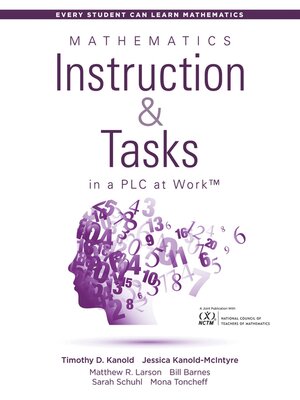Mathematics Instruction and Tasks in a PLC at WorkTM
ebook ∣ (Develop a Standards-Based Math Curriculum in Your Professional Learning Community) · Every Student Can Learn Mathematics
By Timothy D. Kanold

Sign up to save your library
With an OverDrive account, you can save your favorite libraries for at-a-glance information about availability. Find out more about OverDrive accounts.
Find this title in Libby, the library reading app by OverDrive.



Search for a digital library with this title
Title found at these libraries:
| Library Name | Distance |
|---|---|
| Loading... |
Part of the Every Student Can Learn Mathematics series
Improve your students' comprehension and perseverance in mathematical practices. This user-friendly book is divided into two parts, each covering a key team action for mathematics instruction in a PLC at Work™. First you'll examine high-quality research-affirmed math lesson design elements. Then you'll learn how to implement them within your math lesson routines and activities. The book features team discussion tools, sample math lesson designs, strategies for improving student discourse of mathematical concepts, online resources for instructional support, and more.
Implement instructional strategies for math, in a professional learning community:
Contents:
Introduction
Part I: Team Action 1: Develop High-Quality, Essential, and Balanced Lesson-Design Elements
Chapter 1: Essential Learning Standards: The Why of the Lesson
Chapter 2: Prior-Knowledge Warm-Up Activities
Chapter 3: Academic Language Vocabulary as Part of Instruction
Chapter 4: Lower- and Higher-Level Cognitive Demand Mathematical Task Balance
Chapter 5: Whole-Group and Small-Group Discourse Balance
Chapter 6: Lesson Closure for Evidence of Learning
Chapter 7: Mathematics Lesson-Design Tool
Part II: Use Lesson Design Elements to Provide Formative Feedback and Foster Student Perseverance
Chapter 8: Essential Learning Standards and Prior Knowledge Warm-Up Activities
Chapter 9: Using Vocabulary as Part of Instruction
Chapter 10: Implementing Mathematical Task and Discourse Balance
Chapter 11: Using Lesson Closure for Evidence of Learning
Chapter 12: Responding to Lesson Progress With High-Quality Tier 1 Mathematics Intervention
Epilogue
Appendix A
References and Resources
Index
Books in the Every Student Can Learn Mathematics series:







